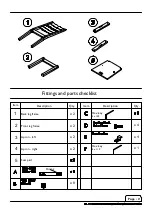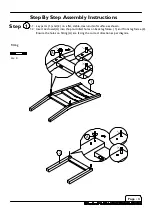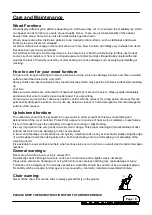
Page : 6
Care and Maintenance
Wood Furniture
Wood display different grain patterns depending on which way they cut - for example, the 'medullary ray' which
can appear on oak furniture is a mark of good quality timber - these are just characteristics of the natural
beauty of the wood. Some furniture is also deliberately aged and rustic.
Wood veneers also allow distinctive patterns to be created on flat surfaces, such as table tops and drawer
fronts by the way silvers are arranged.
All timber surface will change colour and mellow over time. New furniture will initially vary in shade from items
that have been previously purchased.
Our furniture will endure most temperatures in the home but it is best to avoid placing furniture next to heat
sources such as radiators or fires or continued exposure to direct sunlight. Be particularly careful with solid
wood as the lack of humidity caused by central heating can cause damage such as warping and splitting or
cracking.
How to care for your wood furniture
Furniture with frequent dusting will remove abrasive build up, which can damage furniture over time or painted
surface should be dusted with a dry cloth.
Spray polishes are best avoided as they contain silicones which may spoil the furniture's surface when building
up
over time.
Make sure all surfaces are protected from heat and liquids by mats and coasters. Wipe up spills immediately
and ensure that a mat or pad is placed under paper if you are writing.
Do not use a very wet cloth or allow any liquid to contact with the veneers for a long period of time as this can
permanently damage the surface. Do not use any abrasive cleaner or harsh detergent as this can damage the
surface of the veneers.
Upholstered furniture
The upholstery should not be exposed for long periods to direct sunlight as this may cause fading and
deterioration of the cover material. Protect from exposure to sources of heat such as radiators or open flames.
It is recommended to give the upholstery a frequent vacuuming or light brushing.
It is very important to rub very gently to avoid colour change. This proper cleaning will prevent buildup of dust,
soil and oils which can be damaging to the cover material.
In the event of spillage it is imperative to act quickly. Carefully soak up any excess liquid, ideally using the edge
of a white paper towel, then dab gently with a fresh towel taking care to avoid soaking in or spreading of the
remaining liquid.
It is advisable to seek professional help when serious stains occur or when an overall soiled condition has been
reached.
PLEASE KEEP THESE INSTRUCTIONS FOR FUTURE REFERENCE
General warnings:
Never drag furniture when moving it, always lift it.
Periodically check all fixings to ensure none have come loose and re-tighten where necessary.
Please take care when handling or moving the furniture as careless handling may cause damage or injury.
Furniture can be dangerous if incorrectly assembled. Assembly should be carried out by a competent person.
No liability will be accepted for damage or injury caused by incorrectly installed or assembled furniture.
Chair warning:
Never tilt the chair. Ensure the chair is always placed firmly on the ground.
























